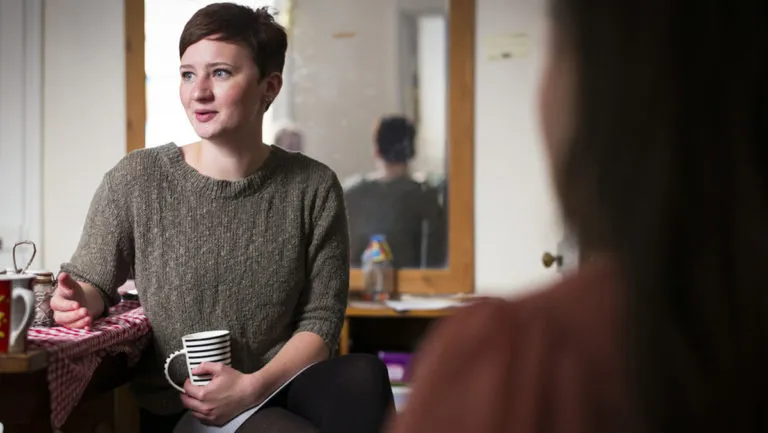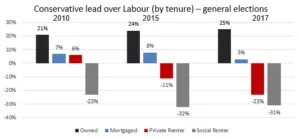Rentquake – coming to a marginal seat near you?
Published: by Robin White

Could private renters decide the next election?
It’s a question recently raised by new Conservative think tank Onward. It highlighted that by the time of the next election, there will be 253 constituencies where more than 20% of voters are renters. That’s an increase from just 18 at the 2001 election.
We were far from surprised by this. Our own research shows that the numbers of renters is growing – and quickly. You can see what this looks like in your area on our interactive map. This matters because the tenure under which you live is increasingly influential in how you vote. Currently, private renters are swinging away from the Conservative party.

The conversation shouldn’t just be about what might happen in 2022, though – because as some commentators have noted, the rentquake has already started and is being felt at the ballot box. In this blog, we’ll look at some of the key seats where the changing face of housing is having an impact on votes.
| Constituency | MP | Party | Majority | Percentage point change in private rented sector (2001-2018) [1] |
| Rossendale and Darwen | Jake Berry | Conservative | 3,216 | 26% |
| Enfield Southgate | Bambos Charalambous | Labour | 4,355 | 29% |
| Southampton Itchen | Royston Smith | Conservative | 31 | 28% |
| Lincoln | Karen Lee | Labour | 1,538 | 28% |
| Scarborough and Whitby | Robert Goodwill | Conservative | 3,435 | 26% |
| Loughborough | Nicky Morgan | Conservative | 4,269 | 25% |
| Bristol North West | Darren Jones | Labour | 4,761 | 25% |
| South Swindon | Robert Buckland | Conservative | 2,464 | 22% |
| Watford | Richard Harrington | Conservative | 721 | 21% |
| Portsmouth South | Stephen Morgan | Labour | 1,554 | 19% |
| Norwich North | Chloe Smith | Conservative | 507 | 29% |
| Canterbury | Rosie Duffield | Labour | 187 | 22% |
| Hastings & Rye | Amber Rudd | Conservative | 346 | 18% |
| Chingford & Woodford Green | Iain Duncan Smith | Conservative | 2,438 | 20% |
[1] Data relates to the relevant local authority
Canterbury
Labour unseating veteran Tory MP Sir Julian Brazier in Canterbury provided one of the upsets of the 2017 general election. Initially, this was put down to Labour’s ability to inspire the youth vote and turn out students. The reality though could be quite different: it might not be the youth vote, but the renter vote that won in Canterbury.
Between 2001 and 2018, Canterbury saw a huge rise in the numbers of private renters, from 14% to 36%. In the same period, home ownership in the constituency fell dramatically.
The result last year in Canterbury could be a powerful indicator of the impact renters might have as a group of swing voters. It is perfectly possible that if the support of renters stays with Labour, then we could see many more Canterburys at the next general election.
Southampton Itchen
Unlike Canterbury, a Labour victory in Itchen (which was represented by the party from 1992 until 2015, and where the Conservative majority is now just 31) might not be that surprising. However, it is one of the handful of seats that generally indicates which party is in the ascendancy, so if the Conservatives want a majority, they need to hold onto places like this.
One of their big challenges in doing this might be that Southampton has seen both a dramatic fall in home ownership and a dramatic rise in renting. In fact, almost half of people in Southampton now rent or live free, while just 38% are homeowners.
This change could mean that rather than being a marginal, Itchen becomes a safe seat. A prelude to this can be seen in the neighbouring constituency of Southampton Test, where in 2017 the Labour majority jumped from just under 4,000 to 11,500.
Lincoln
Interestingly, 2017 was the first time since 1974 that Lincoln hadn’t been won by the largest party in parliament -a record that shows Lincoln is a true bellwether and that last year was something of an anomaly. As you might expect though, there has again been an increase in renting in the area that might have driven it:
- Lincoln in 2001 – 67% home ownership and 14% privately renting or living for free
- Lincoln in 2018 – 42% home ownership and 41% privately renting or living for free
Loughborough
Another bellwether seat is and one represented in parliament by Chair of the Treasury Select Committee and former Cabinet Minister, Nicky Morgan. This is a constituency that the Tories took from Labour in 2010, and by 2015 had turned reasonably safe with an almost 18% majority following the 2015 election.
The last 17 years have seen a 25 percent point change in private renting in the area, and now only 53% of local people own their home. This, as we’ve seen, can (and in Loughborough, is) having an impact, with Morgan’s majority now back down to less than 8%.
The question really is what could this mean in the future? If the Conservatives struggle to hold places like Loughborough, then it becomes correspondingly harder for a Conservative majority government to be formed.
Chingford & Woodford Green
When it comes to elections, everyone is looking for a high-profile politician at risk of being unseated. With a 20 percentage-point increase in private renters since 2001, it could be that the constituency of former Conservative leader Iain Duncan Smith is a possibility for this. Back in 2001, just 18% of people in the local area rented; now it’s up to 38%. Last year, Duncan Smith also saw his majority was reduced to just 5%.
Unless the Conservatives have an offer to renters, moving forwards, we can question how they are going to continue to win in places like this. And increasingly, as Onward has shown, there will be a lot of places facing same scenario.
You can download our full research into the growth in the private rented sector from our Policy Library.